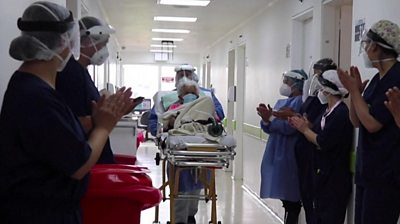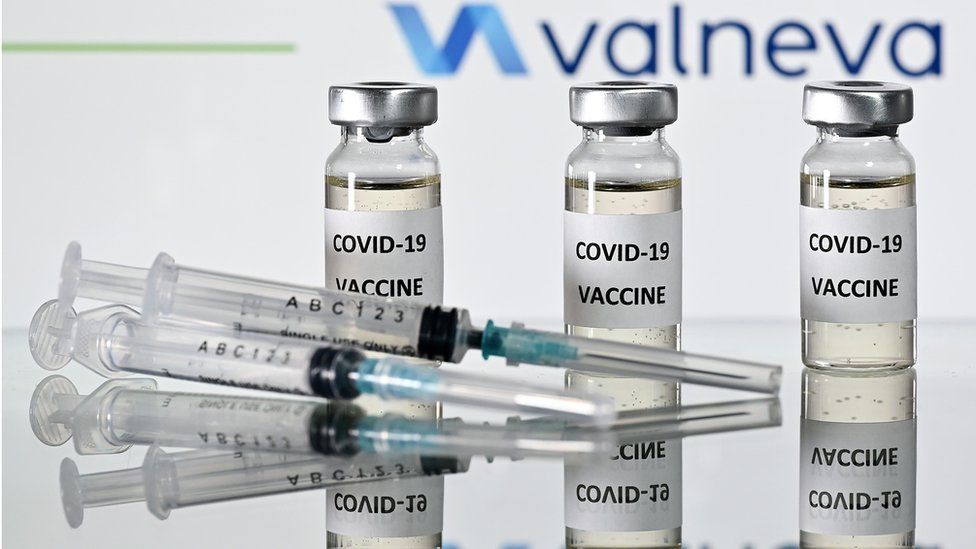As states open vaccines and restaurants to all, wait staff and food service workers are often left behind. Some chefs have even opened pop-up spots to get their employees shots more quickly.Over the course of the pandemic, some of the most dangerous activities were those many Americans dearly missed: scarfing up nachos, canoodling with a date or yelling sports scores at a group of friends at a crowded, sticky bar inside a restaurant.Now, as more states loosen restrictions on indoor dining and expand access to vaccines, restaurant — who have morphed from cheerful facilitators of everyone’s fun to embattled frontline workers — are scrambling to protect themselves against the new slosh of business.“It’s been really stressful,” said Julia Piscioniere, a server at Butcher & Bee in Charleston. “People are OK with masks, but it is not like it was before. I think people take restaurants and their workers for granted. It’s taken a toll.”The return to economic vitality in the United States is led by places to eat and drink, which also suffered among the highest losses in the last year. Balancing the financial benefits of a return to regular hours with worker safety, particularly in states where theoretical vaccine access outstrips actual supply, is the industry’s latest hurdle.In many states, workers are still unable to get shots, especially in regions where they were not included in priority groups this spring. Immigrants, who make up a large segment of the restaurant work force, are often fearful of signing up, worrying that the process will legally entangle them.Some states have dropped mask mandates and capacity limits inside establishments — which the Centers for Disease Control and Prevention still deem a potentially risky setting — further endangering employees.“It is critical for food and beverage workers to have access to the vaccine, especially as patrons who come have no guarantee that they will be vaccinated and obviously will not be masked when eating or drinking,” said Dr. Alex Jahangir, the chairman of a coronavirus task force in Nashville. “This has been a major concern for me as we balance the competing interests of vaccinating everyone as soon as possible before more and more restrictions are lifted.”Servers in Texas are dealing with all of the above. The state strictly limited early eligibility for shots, but last week opened access to all residents 16 and over, creating an overwhelming demand for slots. The governor recently dropped the state’s loosely enforced mask mandate, and allowed restaurants to go forth and serve all comers, with zero limitations.“Texas is in a unique position because we have all these things going on,” said Anna Tauzin, the chief revenue and innovation officer of the Texas Restaurant Association.Michael Shemtov, owner of Butcher and Bee in Charleston, S.C., spoke to a television reporter during a vaccination drive at his restaurant. “If people can’t get appointments, let’s bring them to them,” he said.Ben ChrismanThe trade group is pairing with a health care provider to set aside days at mass vaccines sites in the state’s four biggest cities to target industry workers.The industry has taken matters in its own hands in other places, too.In Charleston, Michael Shemtov, who owns several spots, turned a food hall into a restaurant worker vaccine site on a recent Tuesday with the help of a local clinic. (The post-shot observation seating was at the sushi place; celebratory beers were tipped at an adjoining pizzeria.) Ms. Piscioniere and her partner eagerly availed themselves. “I am super relieved,” she said. “It’s been so hard to get appointments.”In Houston, Legacy Restaurants — which owns the Original Ninfa’s and Antone’s Famous Po’ Boys — is running two vaccine drives for all staff members and their spouses, moves the owners believe will protect workers and assure customers.Some cities and counties are also tackling the problem. Last month, Los Angeles County set aside the majority of appointments for five mass sites two days a week for the estimated 500,000 workers in the food and agriculture industries — half of whom are restaurant staff. In Nashville, the health department has opted to set aside 500 spots daily for the next week specifically for people in the food and hospitality industries. It is possible that restaurants will be able to require their workers be vaccinated in the future.Many business sectors were battered by the coronavirus pandemic, but there is broad agreement that hospitality was hardest hit and that low wage workers sustained some of the biggest blows. In February 2020, for instance, restaurant worker hours were up 2 percent over a previously strong period the year before; two months later those hours were cut by more than half.While hours and wages have recovered somewhat, the industry remains hobbled by rules that most other businesses — including airlines and retail stores — have not had to face. The reasons point to a sadly unfortunate reality that never changed: indoor dining, by nature of its actual existence, helped spread the virus.Tyler Cahill, 29, received his first Pfizer vaccine shot at Workshop, a food court in Charleston.Ben ChrismanA recent report by the C.D.C. found that after mask and other restrictions were lifted, on-premise restaurants led to daily increase in cases and death rates between 40 and 100 days later. Although other settings have turned into super-spreading events — funerals, wedding and large indoor events — many community outbreaks have found their roots in restaurants and bars.“Masks would normally help to protect people in indoor settings but because people remove masks when dining,” said Christine K. Johnson, professor of epidemiology and ecosystem health at the University of California, Davis, “there are no barriers to prevent transmission.”Not all governments have viewed restaurant workers as “essential,” even as restaurants have been a very active part of the American food chains — from half-open sites to takeout operations to cooking for those in need — during the entire pandemic. The National Restaurant Association helped push the C.D.C. to recommend that food service workers be included in priority groups of workers to get vaccines although not all states followed the guidelines.Almost every state in the nation has accelerated its vaccination program, targeting nearly all adult populations.“Most people in our government have considered restaurants nonessential luxuries,” said Rick Bayless, the well-known Chicago restaurateur, whose staff scoured all vaccines sites for weeks to get workers shots. “I think that’s shortsighted. The human race is at its core social and when we deny that aspect of our nature, we do harm to ourselves. Restaurants provide that very essential service. It can be done safely, but to minimize the risk for our staff, we should be prioritized for vaccination.”Texas did not designate as early vaccine recipients any workers beyond those in the health care and education sectors, but is now open to all.“The state leadership decided to ignore our industry as a whole as well as grocery workers,” said Michael Fojtasek, the owner of Olamaie in Austin. “Now because our state leadership has decided to lift a mask mandate while not giving us an opportunity to be vaccinated, it has created this really challenging access issue.” He has switched to a takeout sandwich business for now, and won’t reopen until every worker gets a shot, he said.Jade Fletcher, a server at the County Line in Austin. “I think it is important for them to be vaccinated,” Don Miller, the owner, said of his staff.Ilana Panich-Linsman for The New York TimesMany restaurant owners, however, said that they are going their own way with the rules, and customers often lead them there. “There is a lot of shaming that goes on if you open up and you don’t have your tables six feet apart,” said Don Miller, the owner of the County Line, a small chain in Texas and New Mexico.Moreover, his places continue to require masks and keep them at the hostess station for anyone who “forgets.” Most of his young work force, however, will likely wait a long time for a jab. “I think it is important for them to be vaccinated,” he said. “It hasn’t resonated with them as it hasn’t been available to that age group.”The restaurant industry has many more Latino immigrant workers than most other businesses, and some fear registration for the vaccine is complicating reopenings. Many workers at Danielle Leoni’s Phoenix restaurant, the Breadfruit and Rum Bar, declined unemployment insurance, and have shied from signing up for a shot. “Before you can even make an appointment you have to put in your name and date of birth and email,” Ms. Leoni said. “Those are questions that are deterrents for people trying to keep a low profile.”In Charleston, Mr. Shemtov was inspired by accounts of the immunization program in Israel, which was considered successful in part because the government took vaccines to job sites. “If people can’t get appointments, let’s bring them to them.”Other restaurants are devoting hours to making sure workers know how to sign up, locating leftover shots and networking with their peers. Some offer time off for a shot and the recovery period for side effects.“We don’t want them to have to choose between an hour or pay of a vaccine,” said Katie Button, the owner of Curate and La Bodega in Asheville, N.C.Still, some owners are not taking chances. “If we go out of business because we are one of the few restaurants in Arizona that won’t reopen, so be it,” Ms. Leoni said. “Nothing is more important than someone else’s health or safety.”
Read more →




